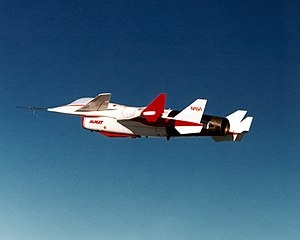avia.wikisort.org - Aeroplane
The Rockwell RPRV-870 HiMAT (Highly Maneuverable Aircraft Technology) is an experimental remotely piloted aircraft that was produced for a NASA program to develop technologies for future fighter aircraft. Among the technologies explored were close-coupled canards, fully digital flight control (including propulsion), composite materials (graphite and fiberglass), remote piloting, synthetic vision systems, winglets, and others.
| Rockwell HiMAT | |
|---|---|
 | |
| HiMAT in flight | |
| Role | Experimental remotely piloted aircraft |
| National origin | United States |
| Manufacturer | Rockwell International |
| First flight | July 27, 1979 |
| Retired | January 1983 |
| Status | On display |
| Primary user | NASA |
| Produced | 1975-1979 |
| Number built | 2 |
Two aircraft were produced by Rockwell International. Their first flights took place in 1979, and testing was completed in 1983.
Design and development
The HiMATs were remotely piloted, as the design team decided that it would be cheaper and safer to not risk a pilot's life during the experiments. This also meant that no ejection seat would have to be fitted. The aircraft was flown by a pilot in a remote cockpit, and control signals up-linked from the flight controls in the remote cockpit on the ground to the aircraft, and aircraft telemetry downlinked to the remote cockpit displays. The remote cockpit could be configured with either nose camera video or with a 3D synthetic vision display called a "visual display".[1] The aircraft were launched from a B-52 Stratofortress at altitude. There was also a TF-104G Starfighter chase plane with a set of backup controls which could take control of the HiMAT in the event that the remote pilot on the ground lost control.[2]
Advances in digital flight control gained during the project contributed to the Grumman X-29 experimental aircraft, and composite construction are used widely on both commercial and military aircraft.[2]
Initial concept included a wedge-shaped exhaust nozzle with 2D thrust vectoring.[3]
Aircraft on display
The two HiMAT aircraft are now on display, one at the National Air and Space Museum and the other at the Armstrong Flight Research Center.[4]
Specifications

General characteristics
- Crew: None
- Length: 22 ft 6 in (6.86 m)
- Wingspan: 15 ft 7 in (4.75 m)
- Height: 4 ft 4 in (1.31 m)
- Empty weight: 3,370 lb (1,529 kg)
- Gross weight: 4,030 lb (1,828 kg)
- Powerplant: 1 × General Electric J85-21 turbojet
Performance
- Maximum speed: 1,218 mph (1,960 km/h, 1,058 kn)
- Maximum speed: Mach 1.6
Gallery
- HiMAT aircraft at the National Air and Space Museum
- HiMAT Remote Cockpit with Synthetic Vision Display
- Initial mockup of HiMAT with two dimensional thrust vectoring
See also
- List of experimental aircraft
- Rockwell-MBB X-31
- McDonnell Douglas X-36
- NASA X-38
References
- Sarrafian, Shahan K. (August 1984). Simulator Evaluation of a Remotely Piloted Vehicle Lateral Landing Task Using a Visual Display. NASA. OCLC 11977763. Technical memorandum 85903; Accession number N84-29885.
- Gibbs, Yvonne, ed. (February 28, 2014). "NASA Armstrong Fact Sheet: Highly Maneuverable Aircraft Technology". NASA. FS-025-DFRC. Retrieved June 12, 2016.
- "NACA/NASA Langley: Celebrating 100 Years". February 3, 2016.
- Smith, Yvette, ed. (April 1, 2009). "April Fool! Look What's in Kevin Petersen's Parking Space!". NASA. Retrieved May 25, 2012.
- "HiMAT Research Vehicle: Historical Snapshot". Boeing. Retrieved May 21, 2014.
- Simonsen, Erik (May 2007). "Turning time ahead" (PDF). Boeing Frontiers: 8–9.
Further reading
- Kempel, Robert W.; Earls, Michael R. (1988). Flight Control Systems Development and Flight Test Experience with the HiMAT Research Vehicles. NASA. OCLC 22037291. Technical paper 2822; Accession number N89-15929.
- Duke, Eugene L.; Jones, Frank P.; Roncoli, Ralph B. (1986). Development and Flight Test of an Experimental Maneuver Autopilot for a Highly Maneuverable Aircraft. NASA. OCLC 21916352. Technical report 2618; Accession number N88-21153.
External links
| Wikimedia Commons has media related to NASA HiMAT. |
- HiMAT Research Vehicle at Boeing.com
На других языках
[de] Rockwell HiMAT
Die Rockwell RPRV-870 HiMAT (Highly Maneuverable Aircraft Technology) war ein Experimentalflugzeug, welches aus einem Entwicklungsprogramm der NASA hervorging. Das HiMAT-Programm wurde im Rahmen eines Ausschreibungsverfahrens der United States Air Force durchgeführt. Hauptsächlich sollten hierbei Technologien für künftige Jagdflugzeuge entwickelt werden. Daneben umfasste das Programm die Entwicklung von Canard-Flügeln, voll digitaler Flugzeugsteuerung (inklusive FADEC), Verbundwerkstoffen, Graphit und Glasfaserverstärktem Kunststoff, unbemannten Luftfahrzeugen, Virtueller Realität für Piloten sowie Winglets. Ziel war es darüber hinaus, ein Kampfflugzeug mit bis dahin noch nicht erreichter Wendigkeit (engl. „Highly Maneuverable“) zu entwickeln. Rockwell International gewann mit seinem Entwurf schließlich das Ausschreibungsverfahren.- [en] Rockwell HiMAT
[fr] Rockwell HiMAT
HiMAT était un avion expérimental créé par Rockwell International[1].Другой контент может иметь иную лицензию. Перед использованием материалов сайта WikiSort.org внимательно изучите правила лицензирования конкретных элементов наполнения сайта.
WikiSort.org - проект по пересортировке и дополнению контента Википедии


